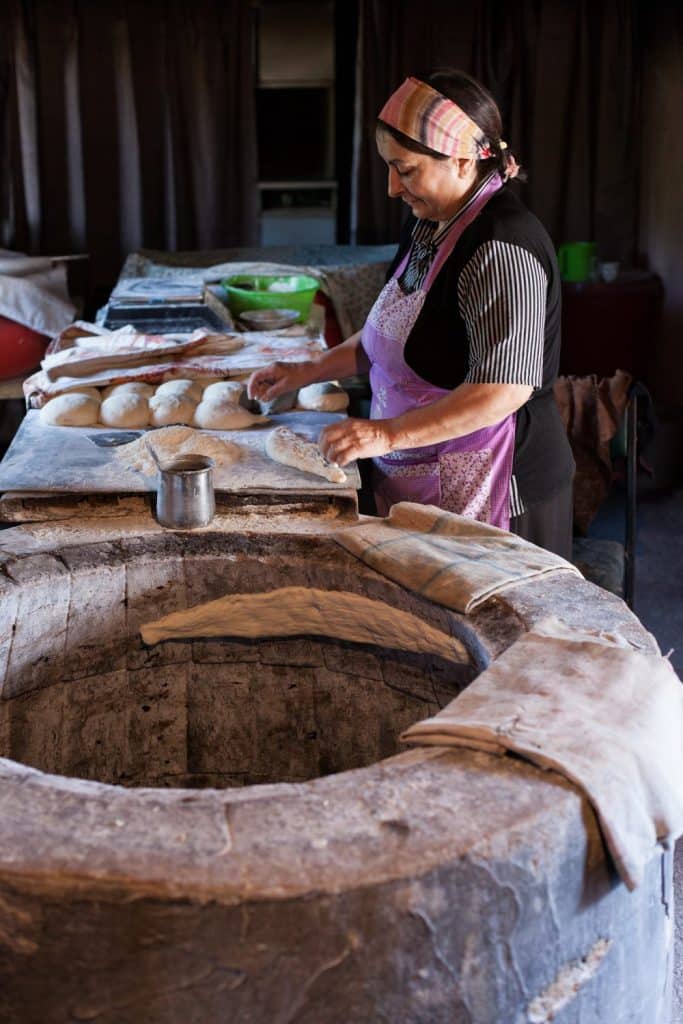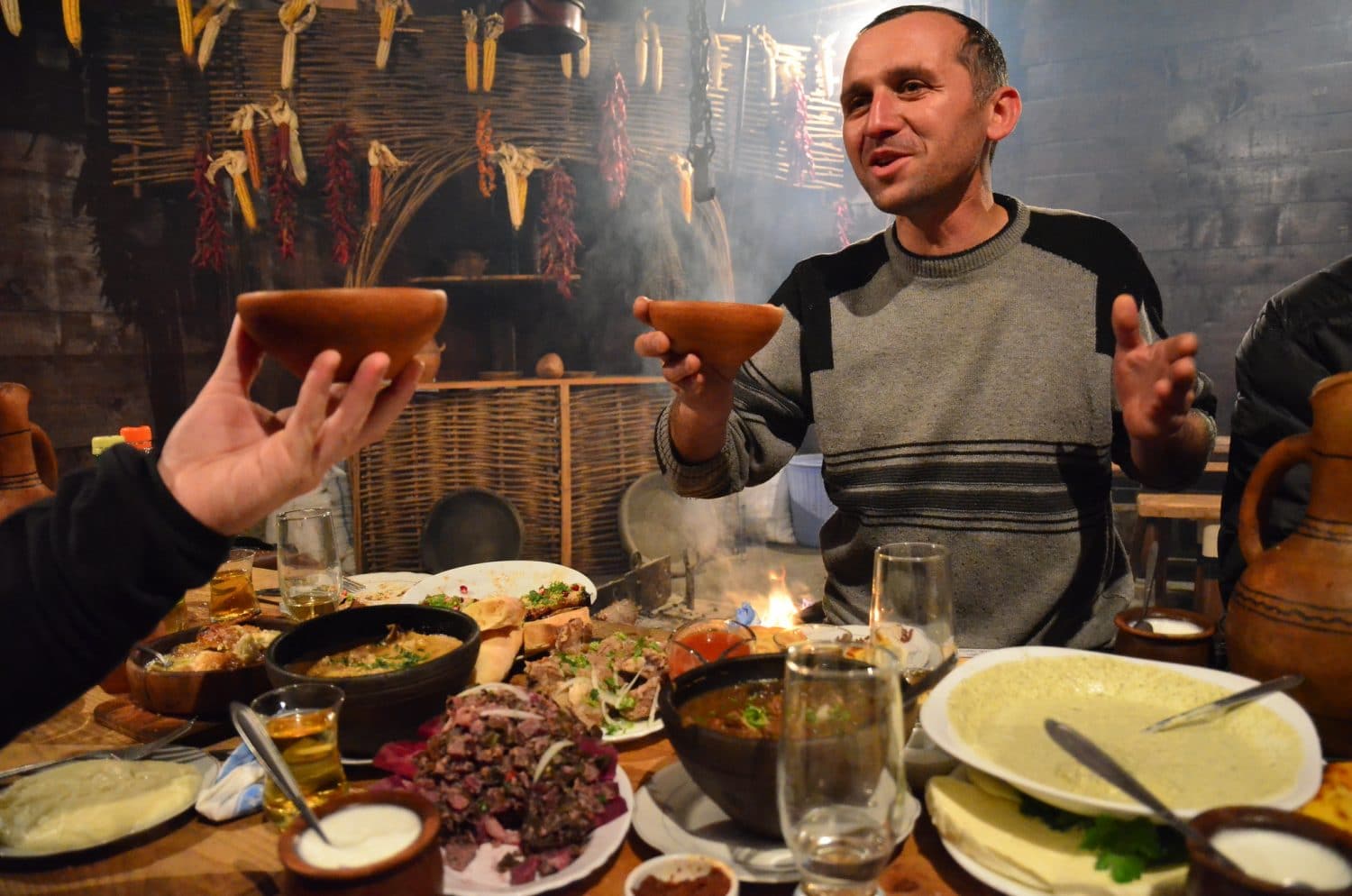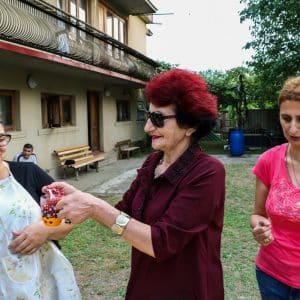As a nutritionist, food is often the driving factor of my travels. I love exploring the local and traditional cuisines which help shape the identity of a country. Georgian culture is strongly influenced by, and perhaps best known for, its unique and vibrant cuisine.
Georgian cuisine in Georgia is packed with fresh and organic produce which are both affordable and easily accessible to locals. Further, small, local production and widely-held food making traditions mean that a variety of fresh, local foods from breads and cheeses to pickles and wines are often produced in the home.
This article will further explore the specific components of Georgian cuisine and food culture that I believe could help explain the reasons for the nation’s nutritional success. Specifically this focuses on balanced nutrition that includes several natural protien sources, the freshness of ingredients used, and socializing traditions surrounding food consumption in Georgia. This article is based on my learning and experiences acquired during a SRAS/Novamova Foodways tour in 2018, which included visits and guided tours to different areas of Georgia, as well as culinary masterclasses where I was able to learn to cook regional dishes using traditional methods and local ingredients.
Eating Habits

Atmosphere: During my time spent with local families and friends in Georgia, I quickly realized that Georgian food culture is complex; it relies not solely on its ingredients, but also on atmosphere, timing, and passion. Typically, food is consumed with the accompaniment of family, friends, and/or guests. Dinner tables are crammed with a wide selection of dishes to allow eaters an opportunity to consume a balanced diet at each meal – each meal generally consists of bread, meat, cheese, and vegetables, all presented in various different forms. Dishes are often presented on smaller serving dishes, but then replaced once they empty to create an atmosphere of bounty for those eating.[/caption]
Time: In Georgia, meals are almost never rushed. Taking time to dine is encouraged so that eating is also a time to relax, refuel, digest, and socialize. Even a Georgian quick breakfast of khatchapuri (cheese bread) and espresso – although relatively quick and simple, still allows for some lingering, and is typically still grabbed fresh from a local baker. To the typical Georgian, eating is almost ritual. For me, experiencing this style of eating felt refreshing. It felt healthy. It felt as though I wasn’t just shovelling calories into my body for energy’s sake, rather feeding my organs with the nutrients it deserved whilst allowing them to absorb each vitamin and mineral required by them.
Food as part of who you are: Georgia’s mountainous geography has allowed the tiny country (which is about the size of West Virginia) to maintain several distinct cultural zones. Each zone typically features a people with their own ethnicity, language, and cuisine. Thus, when we talk about Georgian cuisine, we are really talking about an amalgamation of shared traditions between a number of different peoples, who have all innovated and shared their own creations. The origins of these various dishes, be they from the politically dominant Immereti, the militarily powerful Svaneti, or the busy ports of Adjara, are commonly known in Georgia – and sometimes hotly debated. This means that eating Georgia’s nutritious food is often a process that comes with thinking about who you and your neighbors are, encouraging a healthy sense of identity and community.
Ingredients
Local, fresh produce: Georgian cuisine offers a wide array of traditional dishes that burst with colors, flavors, and nourishment. Georgia lies along the same general latitude as Italy, meaning that it’s a warm country. Of most importance, however, are the extreme Caucasus Mountains, which rise from Georgia’s Black Sea coast and cover much of the country. The coast, mountains, and latitude combine to create a country with an amazing number of biomes, in which a huge variety of fruits, vegetables, nuts, and legumes grow, all within a space about the same size as West Virginia. This creates a natural food economy that allows locals access to a plethora of fresh and organic produce which takes up a large portion of the Georgian diet.

Georgia’s mountainous geography, which makes transport more difficult, has traditionally favored small farms and home processing. The country is also still recovering from the post-Soviet economic collapse and so somewhere around 20-30% of the population continues to be employed by agriculture and food production.
Fresh and organic produce is readily available in farmers markets, where locals sell their homemade dairy products, freshly butchered meats from free-to-range animals, homegrown fruits and vegetables, and home pickled vegetables (the probiotic properties of which offer many health benefits and can aid with digestion).
Non processed foods: the simplicity of Georgian dishes leaves less demand for processing foods and Georgians are proud of their cuisine, so why change it? Of course supermarkets offer a wide range of pre-packed and pre-prepared foods such as yoghurts, condiments and sliced breads, but many still resist spending money on what they see as mediocre, expensive foods when they have small bakeries dotted along every side street piling up fresh breads and farmers markets spilling with homemade, unpasteurized yoghurts fermented by the babushka (older woman) down the road.
The younger generation will enjoy a burger from McDonalds (of which there are only 9 in the whole country!), and maybe you’ll find a bottle of the nation’s tastiest lemonade, Natakhtari, made from natural ingredients and presented at the dinner table, but mainly, Georgian food culture does not leave much room for processed foods. Eating natural and either home-cooked or locally produced foods is an important part of the personal and national identity of man Georgians. This means that the majority of what is consumed is healthier, tastier, and fresher.
Balance: Georgian dinners tend to be complex, with variety and balance. Rarely does the table feel really dominated by one dish or food group.
At almost every sitting you can find carbohydrates – such as the freshly baked, clay oven flatbread (shoti), which is often purchased from a small local bakery. However, the meal is almost never dominated by carbohydrates.

Protein and healthy fats from both animals and plants often abound on the dinner table. Walnuts are very common in salads and even make appearances in main dishes – like Satsivi, a Georgian national dish of poultry cooked in walnut sauce, or Chirbuli, an breakfast dish of eggs, vegetables, and walnuts. Legumes are present in common dishes like Lobio, which is seasoned beans cooked in a clay pot, or even Lobiani, which is bread stuffed with beans, and traditional foods like Mchadi (cornbread) and Ghomi (cornmeal porridge) are also great sources of plant-based proteins.
Dairy products, another good source of protein, also play a dominant role in Georgian cuisine, as is common with most cuisines from mountainous regions. In fact, Georgian dairy products tend to be consumed at almost every meal as sides or even ingredients in main dishes. Matsoni, for instance, is a traditional yoghurt which has a jelly-like and often slightly lumpy consistency. It is often eaten at breakfast or for desert – often with dried fruits, walnuts, and/or honey mixed in. It hosts good bacteria which are able to survive the full journey through the human digestive system and which help improve digestion at each stage.
Cheese is often served alone as a fresh side dish or used in other dishes, such as Khatchapuri (cheese stuffed bread), Khinkali (Georgian dumplings, which can have a variety of fillings), or Nadugi (cheese stuffed with more cheese). Cheeses in Georgia can be easily found in fresh, organic, locally-produced varieties in the farmers markets that dot Georgian villages and cities. Cheese making is also a not-uncommonly-known craft practiced at home.

Meats: The most traditional meats in Georgia are poultry and mutton, although pork and beef are also common. Most famously this includes shashlyk, which is grilled, marinated meat. Interestingly with shashlyk, it is often eaten between bites of fresh greens such as green onion, garlic shoots, cilantro, or even tarragon. This gives the dish more flavor and texture but also much more nutrition: fiber, vitamins, and iron. Georgian soups, like kharcho, are also often rich in meat.
Salads often contain tomatoes and cucumbers and dark greens, and dressed with nuts, oil, and/or cheeses. Pkhali is a remarkable salad made from vegetables blended with nuts and herbs into a thick, moldable paste. It is often eaten on bread. Green beans, spinach, and sorrel are common in side dishes and/or soups.
Sauces are often complex in thier flavors and unique in thier ingredients. Adzhika is a fairly spicy relish while tkemali is a plum sauce meant for meats.
Deserts are reasonably common – but the most traditional of them will be fruit, honey, nut, and/or dairy based. A bowl of fresh fruits (especially peaches, pears, apples, and plums) is common at the end of meal, especially when in season, and often served with tea, which itself helps the food settle and digest while extending the socialization period of the meal.
Wine was invented in the Caucasus and new archeological evidence is constantly being uncovered that keeps pushing the date of its invention back. Announcements of new evidence are always trumpeted loudly by the countries in which it was discovered, as various locations vie for the honor of being the birthplace of wine and revealing how deeply wine runs into local Caucasian identities.
Needless to say, Georgia and other Caucasus countries take winemaking very seriously and have integrated it as a healthy part of their food culture. Georgians take their time to appreciate their tipple. Wine does not just play a sideline role at the dinner table, rather, it plays a key role in supporting the foundations of a Georgian feast. It can accompany food during a typical lunch or dinner. Especially when it is house wine and made on site (also common in Georgia), it will often be presented in a large jug and then evenly distributed among guests. The best known Georgian wines are Kindzmarauli and Saperavi.

Though western-style winemaking techniques are now quite common in Georgia, traditional methods are still used to produce natural wines, and since international interest in Georgian natural wine is on the rise, along with Georgian pride in their heritage, these traditional methods are being increasingly employed by winemakers. In traditional winemaking, little to no sulfites are added. Sulfites are often added to modern wines to allow control and stability, but since traditional Georgian winemaking ferments the grapes along with their skins, seeds, and stems, a natural protection is formed through the release of tannins during the fermentation process.
Summary: Cuisine in Georgia is excellent. Fresh, organic, and free range ingredients provide nourishing and satisfying dishes. Georgia also seems to be turning back to traditional ways and resisting influxes of commercialization. Ancient methods of preserving, cooking, winemaking, cheese making, and farming are all being preserved and passed down to new generations. And once all of these components that help to shape Georgian cuisine are considered, it really doesn’t seem surprising to learn that they bear one of the top spots in health and longevity when compared with the rest of Europe. In fact, it actually feels quite refreshing to experience real, traditional, and simple ways of living. Isn’t this how we are supposed to do it?











